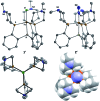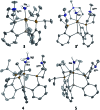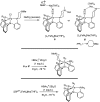Exploring secondary-sphere interactions in Fe-N x H y complexes relevant to N2 fixation
- PMID: 28451336
- PMCID: PMC5363375
- DOI: 10.1039/c6sc04805f
Exploring secondary-sphere interactions in Fe-N x H y complexes relevant to N2 fixation
Abstract
Hydrogen bonding and other types of secondary-sphere interactions are ubiquitous in metalloenzyme active sites and are critical to the transformations they mediate. Exploiting secondary sphere interactions in synthetic catalysts to study the role(s) they might play in biological systems, and to develop increasingly efficient catalysts, is an important challenge. Whereas model studies in this broad context are increasingly abundant, as yet there has been relatively little progress in the area of synthetic catalysts for nitrogen fixation that incorporate secondary sphere design elements. Herein we present our first study of Fe-N x H y complexes supported by new tris(phosphine)silyl ligands, abbreviated as [SiPNMe3] and [SiPiPr2PNMe], that incorporate remote tertiary amine hydrogen-bond acceptors within a tertiary phosphine/amine 6-membered ring. These remote amine sites facilitate hydrogen-bonding interactions via a boat conformation of the 6-membered ring when certain nitrogenous substrates (e.g., NH3 and N2H4) are coordinated to the apical site of a trigonal bipyramidal iron complex, and adopt a chair conformation when no H-bonding is possible (e.g., N2). Countercation binding at the cyclic amine is also observed for anionic {Fe-N2}- complexes. Reactivity studies in the presence of proton/electron sources show that the incorporated amine functionality leads to rapid generation of catalytically inactive Fe-H species, thereby substantiating a hydride termination pathway that we have previously proposed deactivates catalysts of the type [EPR3]FeN2 (E = Si, C).
Figures












Similar articles
-
Exploiting metal-ligand bifunctional reactions in the design of iron asymmetric hydrogenation catalysts.Acc Chem Res. 2015 May 19;48(5):1494-502. doi: 10.1021/acs.accounts.5b00045. Epub 2015 Apr 21. Acc Chem Res. 2015. PMID: 25897779
-
N-H Bond Dissociation Enthalpies and Facile H Atom Transfers for Early Intermediates of Fe-N2 and Fe-CN Reductions.J Am Chem Soc. 2017 Mar 1;139(8):3161-3170. doi: 10.1021/jacs.6b12861. Epub 2017 Feb 17. J Am Chem Soc. 2017. PMID: 28140600 Free PMC article.
-
Structure and reactivity of bis(silyl) dihydride complexes (PMe(3))(3)Ru(SiR(3))(2)(H)(2): model compounds and real intermediates in a dehydrogenative C-Si bond forming reaction.J Am Chem Soc. 2003 Jul 23;125(29):8936-48. doi: 10.1021/ja035916v. J Am Chem Soc. 2003. PMID: 12862491
-
The azomethine ylide route to amine C-H functionalization: redox-versions of classic reactions and a pathway to new transformations.Acc Chem Res. 2015 Feb 17;48(2):317-28. doi: 10.1021/ar5003768. Epub 2015 Jan 6. Acc Chem Res. 2015. PMID: 25560649 Free PMC article. Review.
-
Catalytic N2-to-NH3 (or -N2H4) Conversion by Well-Defined Molecular Coordination Complexes.Chem Rev. 2020 Jun 24;120(12):5582-5636. doi: 10.1021/acs.chemrev.9b00638. Epub 2020 Apr 30. Chem Rev. 2020. PMID: 32352271 Free PMC article. Review.
Cited by
-
Tuning ligand field strength with pendent Lewis acids: access to high spin iron hydrides.Chem Sci. 2019 May 7;10(21):5539-5545. doi: 10.1039/c9sc00561g. eCollection 2019 Jun 7. Chem Sci. 2019. PMID: 31293738 Free PMC article.
-
Hydrogen-bonded nickel(I) complexes.Chem Commun (Camb). 2021 Jan 26;57(6):753-756. doi: 10.1039/d0cc07216h. Chem Commun (Camb). 2021. PMID: 33346759 Free PMC article.
-
Activation of ammonia and hydrazine by electron rich Fe(ii) complexes supported by a dianionic pentadentate ligand platform through a common terminal Fe(iii) amido intermediate.Chem Sci. 2020 Dec 22;12(6):2231-2241. doi: 10.1039/d0sc06466a. Chem Sci. 2020. PMID: 34163989 Free PMC article.
-
Early Metal Di(pyridyl) Pyrrolide Complexes with Second Coordination Sphere Arene-π Interactions: Ligand Binding and Ethylene Polymerization.ACS Omega. 2019 Sep 19;4(14):15879-15892. doi: 10.1021/acsomega.9b01788. eCollection 2019 Oct 1. ACS Omega. 2019. PMID: 31592458 Free PMC article.
-
Activation of Dinitrogen by Polynuclear Metal Complexes.Chem Rev. 2020 Jun 24;120(12):5517-5581. doi: 10.1021/acs.chemrev.0c00042. Epub 2020 May 4. Chem Rev. 2020. PMID: 32364373 Free PMC article. Review.
References
-
-
Selected reviews and examples:
- Holm R. H., Solomon E. I. Chem. Rev. 2004;104:347. - PubMed
- Cook S. A., Borovik A. S. Acc. Chem. Res. 2015;48:2407. - PMC - PubMed
- Cramer C. J., Tolman W. B. Acc. Chem. Res. 2007;40:601. - PMC - PubMed
- Costas M., Mehn M. P., Jensen M. P., Que, Jr. L. Chem. Rev. 2004;104:939. - PubMed
- Ohta S., Ohki Y., Hashimoto T., Cramer R. E., Tatsumi K. Inorg. Chem. 2012;51:11217. - PubMed
- Collman J. P., Boulatov R., Sunderland C. J., Fu L. Chem. Rev. 2004;104:561. - PubMed
- Tsui E. Y., Kanady J. S., Agapie T. Inorg. Chem. 2013;52:13833. - PMC - PubMed
- Chatt J., Leigh G. J. Chem. Soc. Rev. 1972;1:121.
- Kovacs J. A., Brines L. M. Acc. Chem. Res. 2007;40:501. - PMC - PubMed
- Itoh S. Acc. Chem. Res. 2015;48:2066. - PubMed
- Hematian S., Garcia-Bosch I., Karlin K. D. Acc. Chem. Res. 2015;48:2462. - PMC - PubMed
- Lyons C. T., Stack T. D. P. Coord. Chem. Rev. 2013;257:528. - PMC - PubMed
- Citek C., Herres-Pawlis S., Stack T. D. P. Acc. Chem. Res. 2015;48:2424. - PubMed
- Serrano-Plana J., Garcia-Bosch I., Company A., Costas M. Acc. Chem. Res. 2015;48:2397. - PubMed
- Friedle S., Reisner E., Lippard S. J. Chem. Soc. Rev. 2010;39:2768. - PMC - PubMed
-
-
-
Selected reviews and examples:
- Dutta A., Roberts J. A. S., Shaw W. J. Angew. Chem., Int. Ed. 2014;53:6487. - PubMed
- Henry R. M., Shoemaker R. K., DuBois D. L., Rakowski DuBois M. J. Am. Chem. Soc. 2006;128:3002. - PubMed
- Rakowski DuBois M., DuBois D. L. Chem. Soc. Rev. 2009;38:62. - PubMed
- Rauchfuss T. B. Acc. Chem. Res. 2015;48:2107. - PMC - PubMed
- Shook R. L., Borovik A. S. Inorg. Chem. 2010;49:3646. - PMC - PubMed
- MacBeth C. E., Golombek A. P., Young V. G., Yang C., Kuczera K., Hendrich M. P., Borovik A. S. Science. 2000;289:938. - PubMed
- MacBeth C. E., Gupta R., Mitchell-Koch K. R., Young V. G., Lushington G. H., Thompson W. H., Hendrich M. P., Borovik A. S. J. Am. Chem. Soc. 2004;126:2556. - PubMed
- Lacy D. C., Gupta R., Stone K. L., Greaves J., Ziller J. W., Hendrich M. P., Borovik A. S. J. Am. Chem. Soc. 2010;132:12188. - PMC - PubMed
- Carver C. T., Matson B. D., Mayer J. M. J. Am. Chem. Soc. 2012;134:5444. - PubMed
- Constentin C., Drouet S., Robert M., Saveant J.-M. Science. 2012;338:90. - PubMed
- Chang C. J., Chng L. L., Nocera D. G. J. Am. Chem. Soc. 2003;125:1866. - PubMed
- Lee C. H., Dogutan D. K., Nocera D. G. J. Am. Chem. Soc. 2011;133:8775. - PubMed
- Soo H. S., Komor A. C., Iavarone A. T., Chang C. J. Inorg. Chem. 2009;48:10024. - PubMed
- Matson E. M., Bertke J. A., Fout A. R. Inorg. Chem. 2014;53:4450. - PubMed
- Matson E. M., Park Y. J., Fout A. R. J. Am. Chem. Soc. 2014;136:17398. - PubMed
- Wallen C. M., Palatinus L., Bacsa J., Scarborough C. C. Angew. Chem., Int. Ed. 2016;55:11902. - PubMed
-
-
-
Selected reviews and examples:
- Holm R. H., Kennepohl P., Solomon E. I. Chem. Rev. 1996;96:2239. - PubMed
- Lu Y., Valentine J. S. Curr. Opin. Struct. Biol. 1997;7:495. - PubMed
- Kiefer L. L., Paterno S. A., Fierke C. A. J. Am. Chem. Soc. 1995;117:6831.
- Vogt L., Vinyard D. J., Khan S., Brudvig G. W. Curr. Opin. Chem. Biol. 2015;25:152. - PubMed
- Kung Y., Drennan C. L. Curr. Opin. Chem. Biol. 2011;15:276. - PMC - PubMed
- Moore C. M., Dahl E. W., Szymczak N. K. Curr. Opin. Chem. Biol. 2015;25:9. - PubMed
- Fontecilla-Camps J. C., Volbeda A., Cavazza C., Nicolet Y. Chem. Rev. 2007;107:4273. - PubMed
- Fernandez D., Pallares I., Vendrell J., Aviles F. X. Biochimie. 2010;92:1484. - PubMed
- Galinato M. G. I., Spolitak T., Ballou D. P., Lehnert N. Biochemistry. 2011;50:1053. - PMC - PubMed
- Cook S. A., Hill E. A., Borovik A. S. Biochemistry. 2015;54:4167. - PMC - PubMed
-
-
- Hoffman B. M., Dean D. R., Seefeldt L. C. Acc. Chem. Res. 2009;42:609. - PMC - PubMed
- Hoffman B. M., Lukoyanov D., Dean D. R., Seefeldt L. C. Acc. Chem. Res. 2013;46:587. - PMC - PubMed
- Dos Santos P. C., Igarashi R. Y., Lee H.-I., Hoffman B. M., Seefeldt L. C., Dean D. R. Acc. Chem. Res. 2005;38:208. - PubMed
-
- Barney B. M., Igarashi R. Y., Dos Santos P. C., Dean D. R., Seefeldt L. C. J. Biol. Chem. 2004;279:53621. - PubMed
- Seefeldt L. C., Dance I. G., Dean D. R. Biochemistry. 2004;43:1401. - PubMed
- Siegbahn P. E. M. J. Am. Chem. Soc. 2016;138:10485. - PubMed
- Schimpl J., Petrilli H. M., Blochl P. E. J. Am. Chem. Soc. 2003;125:15772. - PubMed
- Hallmen P. P., Kastner J. Z. Anorg. Allg. Chem. 2015;641:118.
- Kastner J., Hemmen S., Blochl P. E. J. Chem. Phys. 2005;123:074306. - PubMed
Grants and funding
LinkOut - more resources
Full Text Sources
Other Literature Sources

